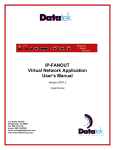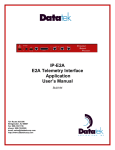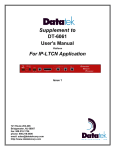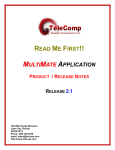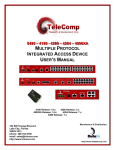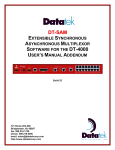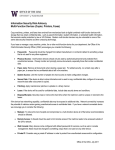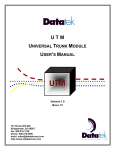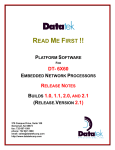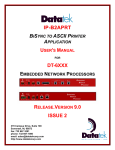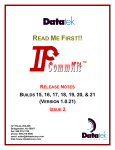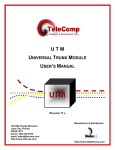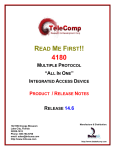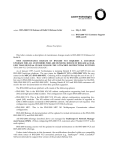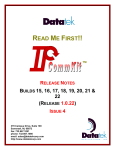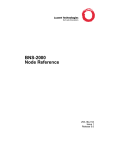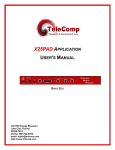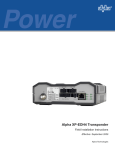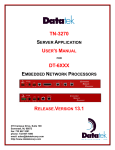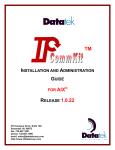Download DT-6061 IP-LTCN Application
Transcript
DT-6XXX LOOP TEST NETWORKING IP-LTCN APPLICATION USER'S MANUAL RELEASE 14 VERSION 1 BUILD 14.1 721 Route 202-206 Bridgewater, NJ 08807 fax: 908.218.1736 phone: 908.218.0500 email: [email protected] http://www.datatekcorp.com DT-6xxx IP-LTCN Application User's Manual CONTENTS 1 FORWARD ......................................................................................................................................... 4 2 GLOSSARY......................................................................................................................................... 5 3 SUGGESTED REFERENCE............................................................................................................. 7 4 THE IP-LTCN MIGRATION SOLUTION ..................................................................................... 8 5 REDUNDANCY & RELIABILITY ISSUES ................................................................................. 10 6 IP-LTCN INTERFACES ................................................................................................................. 11 7 IP-LTCN APPLICATION COMMAND SET................................................................................ 14 7.1 INPUT CONVENTIONS ...................................................................................................................... 14 7.2 LOGIN ............................................................................................................................................. 14 7.3 LOGOUT .......................................................................................................................................... 15 7.4 EXIT ................................................................................................................................................ 15 7.5 CHANGE PASSWORD ....................................................................................................................... 15 7.6 HELP ............................................................................................................................................... 15 7.7 VERSION ......................................................................................................................................... 15 7.8 DISPLAY OF MEASUREMENTS ......................................................................................................... 16 7.9 DISPLAYING CURRENT CONNECTIONS ............................................................................................ 16 7.10 SNOOPING ON BX.25 TRAFFIC ................................................................................................... 17 7.11 CLEAR MEASUREMENTS ............................................................................................................ 17 7.12 VERIFY CONFIGURATION ........................................................................................................... 18 7.13 PROMPT LABELS ........................................................................................................................ 18 7.14 APPLICATION COMMENTS .......................................................................................................... 18 8 IP-LTCN MEASUREMENTS ......................................................................................................... 19 9 THE INSTALLATION COOKBOOK ........................................................................................... 20 10 KNOWLEDGE BASE ...................................................................................................................... 22 11 12 10.1 SPECIFIC MODEM INFORMATION ................................................................................................ 22 10.2 CABLING, ADAPTERS, AND PATCH PANELS ............................................................................... 22 10.3 ISOCHRONOUS LTS CONNECTIONS ............................................................................................ 22 INTERFACE DEFINITION ............................................................................................................ 23 11.1 CONTROL INTERFACE ................................................................................................................. 23 11.2 HOST INTERFACE ....................................................................................................................... 23 11.3 LTS INTERFACE ........................................................................................................................ 23 TAIL CIRCUITS .............................................................................................................................. 25 12.1 03/05/04 OPTION 1 – MAKE THE LTS/DCTU IP NETWORK CAPABLE ..................................................... 25 Datatek Applications Inc. 2 DT-6xxx IP-LTCN Application User's Manual 12.2 OPTION 2 – USE A MODEM TAIL CIRCUIT .................................................................................. 26 12.3 OPTION 3 – USE A MEDIATION DEVICE IN THE CENTRAL OFFICE .............................................. 27 12.4 OPTION 4 – USING AN EXISTING DATAKIT NETWORK................................................................ 28 12.5 WHAT NOT TO DO WITH TAIL CIRCUITS .................................................................................. 29 13 HARDWARE WARRANTY............................................................................................................ 31 14 END-USER LICENSE AGREEMENT FOR SOFTWARE.......................................................... 31 15 14.1 SOFTWARE LICENSE ................................................................................................................... 31 14.2 INTELLECTUAL PROPERTY RIGHTS ............................................................................................. 31 14.3 SOFTWARE SUPPORT .................................................................................................................. 31 14.4 EXPORT RESTRICTIONS .............................................................................................................. 31 14.5 LIMITED WARRANTY ................................................................................................................. 32 14.6 NO OTHER WARRANTIES ........................................................................................................... 32 14.7 SPECIAL PROVISIONS.................................................................................................................. 32 LIMITATION OF LIABILITY....................................................................................................... 32 03/05/04 Datatek Applications Inc. 3 DT-6xxx IP-LTCN Application User's Manual 1 FORWARD The Mechanized Loop Test operations system has been around since what can seem like the dawn of time. It provides a necessary testing function in the maintenance of end user loop facilities. The Mechanized Loop Test operations system has been continually updated to support an ‘up to date’ set of loop elements. The communications between the Mechanized Loop Test operations system contain components that have become manufacturer discontinued. As such, the communications path between the Mechanized Loop Test operations system and the loop test equipment is at risk. The IP-LTCN application will be described as a replacement for all existing communications environments. The IP-LTCN application is an Internet Protocol replacement that has been designed to be used in conjunction with the Tollgrade LoopCare product. Support and feature request issues should be addressed directly to the author of this document. 03/05/04 Datatek Applications Inc. 4 DT-6xxx IP-LTCN Application User's Manual 2 GLOSSARY BNS Broadband Networking System BX.25 Bell System X.25 Protocol Specification. CO Central Office CODEC Coder/Decoder COLO Central Office Co-Location DCN Loop Test System Data Communications Network DCTU Directly Connected Test Unit DK Datakit DMN Digital Measurement Node DMU Digital Measurement Unit IP Internet Protocol LCN Loop Test System Communications Network LMOS Loop Maintenance Operations System LoopCare The new name for the Mechanized Loop Test Operations System. LTCN Loop Test System TCP/IP Communications Network LTS Loop Test System MLT Mechanized Loop Test Operations System NE Network Element OS Operations System OSS Operations Support System RFC Request For Comments (Internet Specifications) SNMP Simple Network Management Protocol 03/05/04 Datatek Applications Inc. 5 DT-6xxx IP-LTCN Application User's Manual TCP Transport Control Protocol TCP/IP Transport Control Protocol over the Internet Protocol UMI Universal Mediation Interface (Datakit/BNS interface module) URP Universal Receiver Protocol 03/05/04 Datatek Applications Inc. 6 DT-6xxx IP-LTCN Application User's Manual 3 SUGGESTED REFERENCE The following documents are resident at http://www.datatekcorp.com under the documentation button. Document Scope DT-6xxx Platform User’s Manual. Describes the DT-6xxx Embedded Network Processor infrastructure and command set. This includes configuration information, hardware specifications, and SNMP MIB support. The DT-6xxx is the infrastructure on which the Mechanized Loop Test communications applications reside. DT-4000 User’s Manual. Describes the DT-4000 multi-protocol access device. The DT-4000 implements special functions enabled by the IP-LTCN to interface with LTS and DCTU interfaces. DT-4180 User’s Manual Describes the DT-4180 access device. The DT-4180 implements special functions enabled by the IP-LTCN to interface with LTS and DCTU interfaces. DT-4216, DT-4232, DT-4280 Describes the DT-42xx series of access devices. The DT-42xx implements the User’s Manual special functions enabled by the IP-LTCN to interface with LTS and DCTU interfaces. 03/05/04 DT-6xxx Redundant Operation Describes the method of operating the DT- White Paper. 6xxx in a 1+1 sparing configuration. Datatek Applications Inc. 7 DT-6xxx IP-LTCN Application User's Manual 4 THE IP-LTCN MIGRATION SOLUTION The IP-LTCN application is a migration solution for all variants of the Loop Test Communications Environments. It is designed to be used in conjunction with an Internet Protocol conversion of the Tollgrade LoopCare product. The LoopCare product is the evolution of the Lucent Technologies MLT operations system. The IP-LTCN can replace a DCN in its entirety. This eliminates a maintenance risk since the DCN is manufacturer discontinued, with a consequential shortage of spare parts. A side benefit is that the IP-LTCN will free up the 120 square feet of conditioned floor space taken up by the DCN. The IP-LTCN supports an enhanced TCP/IP interface to the LoopCare host. This allows connectivity with the LoopCare hosts using an IP infrastructure. The new LoopCare hosts do not have either a BX.25 interface to communicate with a DCN, nor a fiber interface to communicate with a BNS node. Instead, the LoopCare hosts have implemented a direct TCP/IP interface to the IP-LTCN application. The following diagram shows this arrangement: IP-LTCN Deployment TCP/IP Hosts DT-6xxx IP-LTCN Application LoopCare IP Network LoopCare Central Office LTSs DT-4xxx DT-4xxx BX.25 Central Office LTSs Private Lines Async DMUs BX.25 Async BX.25 DMUs DCTUs 03/05/04 5ESS DCTUs Datatek Applications Inc. 5ESS 8 DT-6xxx IP-LTCN Application User's Manual In the diagram above, the asynchronous DMUs would be accessed directly by the LoopCare OS host. The LoopCare OS host would establish a TCP connection with the DT-4xxx port to which the DMU is attached. Data exchange would proceed using RFC 854 encapsulation as normal. The LTS connections (and DCTU connections via the 5ESS) would be exactly the same as in the LCN or DCN cases. That is, the LTS link is connected to the DT-4xxx port. The DT-4xxx port is configured to originate a TCP connection to the IP-LTCN at the TCP port number corresponding to the LTS identification. The OS host connections to the IP-LTCN are done directly using TCP/IP. This is done at the designated TCP port number for this type of interface. See the interface section of this document for more details. The host protocol suite is fully supported. Status information of the LTS connections will be available if the MLT OS host desires. 03/05/04 Datatek Applications Inc. 9 DT-6xxx IP-LTCN Application User's Manual 5 REDUNDANCY & RELIABILITY ISSUES The Loop Test operation requires a very high reliability. Each solution provides some form of protection. However, the IP-LTCN is superior in all regards. The DCN approach to this type of reliability was in having the ability of multiple “A” cabinets access an LTS on a single “B” cabinet. The MLT host would then be attached to two “A” cabinets. If a BX.25 link from the host to the “A” cabinet would fail, test operations would proceed on the alternate connection. If an “A” cabinet would fail, the alternate “A” cabinet would still be attached to the host and could proceed with the test operations. However, if a “B” cabinet should fail; then all the LTS connections would not be protected. An engineer would need to re-cable the LTS links to another “B” cabinet manually. The LCN approach to this type of reliability was hinged on the DKAP making the outbound calls to the SAM endpoints on the BNS network. Should the DKAP fail, then all connections would be torn down. A new DKAP would then be brought into service manually. The MLT host would then reconfigure the DKAP and establish new calls to the LTS endpoints on the SAM. Note that this is a manual operation since the address groups for the DKAP to which the MLT OS hosts make the call need to be unique to a single DKAP channel sets. Consequently, they cannot be pooled reliably. Consult the BNS documentation for more information. The IP-LTCN application relies on the DT-6xxx redundancy infrastructure for its reliability. The DT-6xxx infrastructure provides 100% reliability through a 1+1 spare arrangement. Should a DT-6xxx fail, the spare would immediately take over automatically. The spare would become the active DT-6xxx in the set, and assume the public IP address of the set. It should be noted that the application interfaces do not need to change, or even be made aware, of the duplex nature of the DT-6xxx redundancy. The IP-LTCN implements both the “A” and “B” cabinets of the DCN, and all interface paths of the LCN. Consequently, the IP-LTCN is the most reliable solution possible for the loop test environment. Consult the DT-6xxx redundancy documentation for more information. Redundancy is optional. It is not required by the IP-LTCN application. 03/05/04 Datatek Applications Inc. 10 DT-6xxx IP-LTCN Application User's Manual 6 IP-LTCN INTERFACES The TCP port numbers associated with a DT-6xxx application are normally referenced by which instance the application is installed. The IP-LTCN is different in that premise because of the large number of distinct TCP port numbers, the need to simplify administration, and engineering configurations. The IP-LTCN application may only be installed on instance #1 of the DT-6xxx. Installing on any other instance will result in a periodic alarm after which the IP-LTCN will proceed to sleep perpetually. Consult the DT-6xxx infrastructure manual for information on how to install an application. The TCP Numbers associated with the IP-LTCN application (using instance #1 as required) are as follows: Set #Channels TCP Port# Usage OA&M 1 10001 Configuration and administration of the IP-LTCN application. This is the standard configuration TCP port number for instance #1. The general formula is 10,000 + instance#. Connections to this TCP port are made via a Telnet client. Host 20 30001 - 30020 These are the host data port connections. They are maintained as separate TCP port numbers so that every LoopCare OS host may be configured uniquely. In that manner, access is always guaranteed for a particular host. 03/05/04 Datatek Applications Inc. 11 DT-6xxx IP-LTCN Application User's Manual Control 20 31001 - 31020 Each of these TCP ports reports status, and provides a mechanized control interface to a host. This interface is documented as an appendix to this document. All of the control connections are equivalent. They are maintained as separate TCP ports so that each one may be configured uniquely. LTS 768 40000 + LTS ID There are a total of 768 TCP ports reserved for LTS connections. These are from 40,001 through 40,768 and correspond to LTS ID 1 through 768 inclusive. This is identical to a physical mapping on a DCN “B” cabinet. BX.25 from the LTS connections are terminated by the IP-LTCN on these connections. An example of how these circuits are used follows: The IP-LTCN would be assigned to instance #1 on the DT-6xxx. Once done, the IPLTCN will listen for inbound TCP connections on all of the TCP port numbers specified above. Each DT-4xxx port on which an LTS is connected then originates a TCP call to the IPLTCN application at its LTS identification TCP port number (40,001 to 40,768). The IPLTCN will then establish and terminate the BX.25 protocol to the LTS on these connections. 03/05/04 Datatek Applications Inc. 12 DT-6xxx IP-LTCN Application User's Manual A TCP/IP LoopCare OS host responsible for control functions, including address upload, would attach any of the TCP port numbers between 31,001 and 31,020. This connection is optional, and not required for the proper operation of the IP-LTCN. Any TCP/IP LoopCare OS host may also make a connection to the IP-LTCN at TCP port numbers 30,001 to 30,020. No correspondence exists between the TCP ports used for host interfaces, and the TCP ports used for control interfaces. All control interfaces are equivalent to each other. All host interfaces are equivalent to each other. The multitude of each type is to allow for simultaneous access for different hosts. Once both the LoopCare OS host and LTS endpoints have established connections; the IP-LTCN can emulate the DCN/LCN functions as needed. 03/05/04 Datatek Applications Inc. 13 DT-6xxx IP-LTCN Application User's Manual 7 7.1 IP-LTCN APPLICATION COMMAND SET INPUT CONVENTIONS All parameters may be given on the command line. Parameters of the form name=<value> may be given in any order. For several complex commands, listed below, missing parameters, or corrections of errors in given parameters, of the form name=<value> are collected by prompting the console user. The user responds to a prompt for the name by typing the required <value> followed by newline. Defaults are supplied in some cases, so the user need only enter newline. Commands may be entered in upper or lower case. Parameters of the form name=value may use upper or lower case for name. Default values, if any, are shown in parenthesis as part of the prompt. Case is not preserved for values. Backspace erases one character. 7.2 LOGIN Syntax: login PASSWD=<password> The login command is used to allow access to the other configuration commands. The login command is only visible when the application is in the logged out (i.e. secure) mode. The unit enters this mode whenever a logout command is issued or when the Telnet to the application instance OA&M TCP port is interrupted for any reason. The password is not echo-suppressed. The password consists of up to seven alphanumeric characters. Special characters are not allowed. The default password is “initial”. If no password is given, the IP-LTCN will prompt for a password. In the prompted mode, the password is not echoed. Instead an asterisk is echoed for each character. 03/05/04 Datatek Applications Inc. 14 DT-6xxx IP-LTCN Application User's Manual 7.3 LOGOUT Syntax: logout The logout command is only allowed if the console user is logged in. It uses no arguments. It will set the console to the logged out mode. 7.4 EXIT Syntax: exit The exit command is only allowed if the console user is logged in. It uses no arguments. It will set the console to the logged out mode, and drop the telnet connection. It is useful where a daisy chain of telnet connections are used to negotiate a firewall network. 7.5 CHANGE PASSWORD Syntax: chgpass PASSWD=<old> NEWPASS=<new> CONFIRM=<new> The chgpass command is used to change a user password on the system console. The command is only allowed if the user is logged in. All three parameters must be given on the same line as the command. None of those entries are echo-suppressed. If the current password is valid, and the two entries for the new password match, the password is changed to the new value. 7.6 HELP Syntax: help |? [Command] The help command is always visible. The help command displays the currently allowed commands for the mode that the unit is currently entered. The alternate command for help is a question mark. 7.7 VERSION Syntax: ver 03/05/04 Datatek Applications Inc. 15 DT-6xxx IP-LTCN Application User's Manual The version command is only visible when the application is logged in. The command has no arguments. It displays the current software and database revisions of the application. . 7.8 DISPLAY OF MEASUREMENTS Syntax: dmeas [ ALL | CTL <RANGE> | OS <RANGE> | LTS <RANGE> The dmeas command is only visible when the application is logged in. The command is used to display the current measurements on any of the interfaces. The dmeas command may display the measurements for a single interface, or all of the interfaces. Where the value of <RANGE> is specified, the identifier may be a single numeric (e.g. the number ‘3’), a numeric range (e.g. ‘1-3’), or the value ‘ALL’ to indicate the entire allowed numeric range. The LTS <RANGE> option will display the measurement information for the LTS connection to the IP-LTCN. The <RANGE> may have values between 1 and 768 inclusive to match the LoopCare OS numbering scheme. The CTL <RANGE> option will display the measurement information for the IP-LTCN mechanized control interfaces. The values in the <RANGE> are 1 through 20 inclusive that correspond one for one to the TCP port numbers 31,001 through 31,020 inclusive. There is no requirement that these interfaces be attached in any particular order. The OS <RANGE> option will display the measurement information for the Operations System interface to the IP-LTCN application. The values in the <RANGE> are 1 through 20 inclusive that correspond one for one to the TCP port numbers 30,001 through 30,020 inclusive. The Operations System hosts are not required to attach these interfaces in any order. When measurements are displayed via the dmeas command, and more than a single entity has been specified; only non-zero entries are actually displayed. 7.9 DISPLAYING CURRENT CONNECTIONS Syntax: dc 03/05/04 Datatek Applications Inc. 16 DT-6xxx IP-LTCN Application User's Manual The dconn command is used to display all of the current connections into the IP-LTCN application. This includes all of the LTS, Control Interface, and Operations System native connections. Please note that the command does not require any arguments. The command will issue a report that shows the connection peer for each active connection. 7.10 SNOOPING ON BX.25 TRAFFIC Syntax: snoop [ OFF | OS <#> | LTS <#> ] The IP-LTCN application has a diagnostic ability to snoop on any of interfaces which carry user data. This is done with the snoop command. All output is directed to the OA&M connection. If the command is invoked with no arguments, it produces a report of all active snooper configurations. If the command is invoked with the OFF option, all of the active snooper configurations are disabled. If the command is invoked with the LTS <#> option, the LTS interface specified is snooped. The <#> is in the range of 1 to 768 to be compatible with the LoopCare OS numbering scheme. Output is displayed on the OA&M session. Please note that this could be extensive for a moderately busy BX.25 line. Both BX.25 and session data are displayed. The session data messages are decoded. If the command is invoked with the OS <#> option, the OS interface specified is snooped. The <#> is in the range of 1 to 20 inclusive and correspond to host interfaces on TCP ports 30,001 through 30,020. The OS interface does not have a BX.25 protocol present, but frame data is decoded and displayed on the OA&M session. Please note that this could become rather voluminous for even a lightly loaded OS interface. 7.11 CLEAR MEASUREMENTS Syntax: clr 03/05/04 Datatek Applications Inc. 17 DT-6xxx IP-LTCN Application User's Manual The measurements displayed with the dmeas command are aggregated until cleared. The clear command will set all measurements to zero. The command has no arguments. 7.12 VERIFY CONFIGURATION Syntax: vfy The configuration of the IP-LTCN application is displayed with the vfy command. The command has no arguments. 7.13 PROMPT LABELS Syntax: label [ “Double Quoted String” | NONE ] The label command is used to give the command console a unique prompt. The command is visible only when logged into the IP-LTCN administrative console. If the label command is invoked without arguments, the current configuration of the label is displayed. If the argument to the label command is the word ‘none’, any current label is set to a null value. If the argument to the label command is a double quoted string, the contents of the string becomes the application console prompt label. A console label may be up to 31 characters in length. 7.14 APPLICATION COMMENTS Syntax: comment [ L1=”Any Comment”] [ L2=”Any Comment”] [ L3=”Any Comment”] The IP-LTCN application may have comments which are displayed with the verify configuration command. Up to three lines of comments are available. Each line may have a comment up to 64 characters in length. Each comment is double quoted to allow for spaces to be embedded. A comment with no characters (i.e. “”) is used to delete a comment which is not desired. It is not necessary to delete prior to adding a new comment. The new comment shall replace the existing comment at the line specified. 03/05/04 Datatek Applications Inc. 18 DT-6xxx IP-LTCN Application User's Manual 8 IP-LTCN MEASUREMENTS This section itemizes the measurements available using the display measurements (dmeas) command. The base measurements are always displayed, and the error and exception counters are only displayed if nonzero. The BX.25 measurements available are as follows: Measurement Description Type Number of LAPB Frames Received Base Number of LAPB Frames Transmitted Base Number of LAPB Bytes Received Base Number of LAPB Bytes Transmitted Base Number of Invalid Frames Received. Exception Number of Frames Ignored when Link is not Inactive. Exception 03/05/04 Datatek Applications Inc. 19 DT-6xxx IP-LTCN Application User's Manual 9 THE INSTALLATION COOKBOOK This section is a series of installation instructions for the deployment of the IP-LTCN application. The TCP/IP capable LoopCare host uses the OS native protocol TCP ports on the IPLTCN application to make their connection. A connection to a Control TCP port is not required, but may be used by the LoopCare host to acquire link status information for the attached LTS endpoints. Consider the following connectivity diagram: TCP/IP Deployment Co-Location NOT Required DT-6xxx IP-LTCN Application 10/100 BaseT LoopCare IP IP IP WAN IP 10/100 BaseT BX.25 BX.25 Any Network LoopCare LTS Or DT-4xxx Direct Connection LTS BX.25 In the diagram above, none of the components are required to be located with each other. The communications between components is via the IP infrastructure. The LoopCare OS hosts communicate directly with the IP-LTCN using TCP/IP and the protocol suite. It should be noted that this configuration is exceptionally economical both in terms of equipment and facility expenses. A typical deployment would have one DT6xxx and eight DT-4xxxs. 03/05/04 Datatek Applications Inc. 20 DT-6xxx IP-LTCN Application User's Manual Given the above, the deployment could be as follows: 1. Install each DT-6xxx by assigning an IP address, gateway address (if any), and the IP-LTCN application on instance #1. These are done by the ipaddr <ip_address>, the gateway <ip_address>, and the app 1 type=ip_ltcn commands on the DT-6xxx system console. It will be necessary to reboot the DT-6xxx following the IP address configuration. This step may be staged in advance of the deployment. 2. Configure the DT-4xxx ports so that they initiate a TCP call to the IP-LTCN application at the TCP port appropriate for its function. The following assumes external clocking via a modem set such as a 202T. Port <#> type=ORIG Dest=<DT-6xxx IP Address> dport=<40000+LTS#> Port <#> prot=HDLC pap=ON dxe=DTE clk=norm enc=nrz Rs <#> The cable adapter is a SYNC DTE with a DB-25 Male. This attaches to the cable of the 202T modem to the Network Element. The <40000+LTS#> is for LTS ports in this configuration. The OS connections are native TCP/IP. That is, the LTS port picks a unique TCP number associated with its LTS identifier. For an LTS identifier of 333, the TCP port is 40333 or 40000 + the LTS identification. The <#> is the DT-4xxx port number being configured. Since the “permanently active” option is configured, the TCP call will be immediately set up. Doing a “display connections” command (dc) on either the DT-4xxx or the IP-LTCN OA&M session will show the LTS connection at this time. The clock option normally defaults to ‘normal’ operation, and the encoding normally defaults to NRZ. However, making the specification is not harmful. 3. No further configuration is required. 03/05/04 Datatek Applications Inc. 21 DT-6xxx IP-LTCN Application User's Manual 10 KNOWLEDGE BASE This section is a random collection of information that may be relevant during the deployment of the IP-LTCN application. In order to avoid duplication and potential for error, much of the information in this section has been moved to their respective User’s Manuals. 10.1 SPECIFIC MODEM INFORMATION Information about the configuration of specific modem sets are now exclusively covered in the DT-4000 User’s Manual, the DT-42xx User’s Manual, and the DT-4180 User’s manual. In the Build #20 version of the DT-4000 User’s Manual, it is on page 58 under section 15 “Cabling”. In the Build #3 version of the DT-4180 User’s Manual, it is on page 50 and section 14. 10.2 CABLING, ADAPTERS, AND PATCH PANELS Consult the DT-4000 User’s manual for Build #20 or higher, the DT-42xx User’s manual Build #1.0 or higher, or the DT-4180 User’s manual Build #3 or higher. These manuals cover the DT-9116 Intelligent Patch Panel, and the various wiring adapters. 10.3 ISOCHRONOUS LTS CONNECTIONS This section is covered in the appropriate DT-4xxx User’s manual under the heading “Synchronous Protocols with Recovered Clocks”. In the DT-4000 build #20 manual, this is section 16 on page 67. A similar section is covered in the DT-4180 User’s manual. 03/05/04 Datatek Applications Inc. 22 DT-6xxx IP-LTCN Application User's Manual 11 INTERFACE DEFINITION The intent of this section is to define the interfaces used by the IP-LTCN application for reference during troubleshooting activity in the field. The interfaces may be monitored both within the IP-LTCN application, and by external means such as a LAN sniffer or a serial line protocol analyzer on the DT-4xxx port. The interfaces are partitioned by the TCP port on which they interface. There are three types of interfaces. These are the IP-LTCN control interface, a TCP/IP host interface, and a BX.25 LTS interface. 11.1 CONTROL INTERFACE The control interfaces to the IP-LTCN accept a connection on TCP ports 31,001 through 31,020 inclusive. Each of the control interfaces are equivalent to each other. The intent of the interface is to provide a mechanized means for a host to acquire information about the operation of the IP-LTCN application. Configuration of the IP-LTCN application is not performed on the control interface. 11.2 HOST INTERFACE The host interface to the IP-LTCN accepts a connection at TCP port between 30,001 and 30020 inclusive. Each TCP port has a hunt group of exactly one. They are maintained unique to prevent a rogue host from locking out its partner. The host interface provides the means by which messages may be sent to an LTS and responses directed to the originating host. Spurious messages from an LTS are sent to all connected hosts simultaneously. Duplication of spurious messages is prevented by the IP-LTCN. 11.3 LTS INTERFACE The LTS interface to the IP-LTCN accepts a connection at TCP port between 40,001 and 40,768 inclusive. Each TCP port has a hunt group of exactly one. They are maintained unique to provide an exact mapping to a particular LTS. Exactly one DT-4xxx (e.g. DT-4000, DT-4180, DT-4216, DT-4232, DT-4280) port may make a connection to 03/05/04 Datatek Applications Inc. 23 DT-6xxx IP-LTCN Application User's Manual an IP-LTCN TCP port for a particular LTS ID. The DT-4xxx provides “B” cabinet functions for the IP-LTCN. 03/05/04 Datatek Applications Inc. 24 DT-6xxx IP-LTCN Application User's Manual 12 TAIL CIRCUITS The IP-LTCN has several deployment options. Many RBOCs will chose to implement a “DCN Drop-In” where the IP-LTCN is dropped in place of an existing DCN. When this occurs, a “tail circuit” will exist for some period of time. This section details the tail circuit deployment. Because of the unique nature of the LTS and DCTU endpoints; special care must be used in the selection of the tail circuit transport. In the sections below, several options for tail circuits are presented. Any of these can be used interchangeably. In addition, an improper scenario is presented. This last incorrect scenario is certain to present a failure situation because of timing issues. Consequently, it is specifically not supported by the IP-LTCN. 12.1 OPTION 1 – MAKE THE LTS/DCTU IP NETWORK CAPABLE This option is simply where the LTS or DCTU is made IP network capable. This is done with a DT-9480 network adapter. A connectivity diagram of this solution is as follows: IP-LTCN Deployment Direct LTS/DCTU to IP using DT-9480 DT-6xxx IP-LTCN Application LoopCare IP Network LoopCare Central Office Central Office IP Network LTSs IP Network IP LTSs IP IP IP DMUs DMUs DCTUs 5ESS 5ESS DCTUs When the LTS or DCTU is made IP network capable with a DT-9480 adapter, there is no mediation equipment of any kind required. It is an easy and clean method of eliminating the tail circuit. 03/05/04 Datatek Applications Inc. 25 DT-6xxx IP-LTCN Application User's Manual 12.2 OPTION 2 – USE A MODEM TAIL CIRCUIT This option is really nothing more than the status quo after the DCN has been initially replaced. The DT-4xxx mediates to a BX.25 connection. These are then distributed by modem tail circuits to the LTS or DCTU. IP-LTCN Deployment Modem Tail Circuits DT-6xxx IP-LTCN Application LoopCare IP Network LoopCare DT-4xxx Central Office LTSs Private Lines Async DMUs DCTUs BX.25 5ESS The diagram above has such a configuration. The DT-4xxx series works in conjunction with the DT-6xxx IP-LTCN to handle the IP to BX.25 mediation in a manner suitable for the LTS and/or DCTU. Since the modem circuits are constant latency, they can be distributed remotely. This option has on-going costs of maintaining the tail circuits; but is otherwise trouble free. 03/05/04 Datatek Applications Inc. 26 DT-6xxx IP-LTCN Application User's Manual 12.3 OPTION 3 – USE A MEDIATION DEVICE IN THE CENTRAL OFFICE One of the most common approaches is to distribute the DT-4xxx mediation devices to the central offices. The DT-4xxx mediation devices support other systems such as SCC connections and E2A telemetry and are shared with IP-LTCN usage. A diagram of that deployment is as follows: IP-LTCN Deployment Distributed Mediation DT-6xxx IP-LTCN Application LoopCare IP Network LoopCare Central Office LTSs DT-4xxx BX.25 BX.25 Async DMUs DCTUs 5ESS In the above diagram, it can be noted that any port may support one or any protocol. Several operations systems can share a single mediation device and reduce the overall cost of deployment considerably. The DT-4xxx mediation device insures the proper timing and presentation of the interface to the LTS and DCTU using local (B)X.25 or isochronous cabling at the Central Office. 03/05/04 Datatek Applications Inc. 27 DT-6xxx IP-LTCN Application User's Manual 12.4 OPTION 4 – USING AN EXISTING DATAKIT NETWORK Another common approach is to use an existing Datakit network for distribution of the LTS/DCTU circuits. This only works because the Datakit network is connection oriented and has a constant latency. Consequently, the timing functions of the DT-4xxx LTCN interface are preserved within the Datakit network. Typically, a SAM is used at either endpoint. Consider the following diagram: Tail Circuit Distribution Via Datakit/BNS BNS-2000 DT-6xxx w/ IP-LTCN UTM TCP/IP BNS-2000 ANY SAM or DT-4000 Central Office U T T T T C E E M O R R N M M 3 3 2 2 T E R M 3 2 T E R M 3 2 BNS-2000 SAM Trunk Any SAM DT-4xxx DK RJ-Xover cables 5ESS DCTU BX.25 BX.25 LTS DMU DT-4xxx Notes: Isochronous operation is supported only by the DT-4xxx. A UTM is the preferred BNS trunk in this deployment. In the diagram above, the mediation occurs at the DT-4xxx interface. The BNS network then transports the BX.25 preserving both the format and the timing. Isochronous connections must be connected directly to a DT-4xxx device since the BNS network and the SAM in particular cannot support that protocol. 03/05/04 Datatek Applications Inc. 28 DT-6xxx IP-LTCN Application User's Manual 12.5 WHAT NOT TO DO WITH TAIL CIRCUITS As explained in the previous section, the distribution of LTS/DCTU connections does work with the Datakit/BNS network. It does so because Datakit/BNS is a connection oriented network with constant paths and constant delays. Both of these assumptions are not true with an IP based network. There is considerable logic in the DT-4xxx to account for the anomalies in the IP network between the DT-6xxx and the DT-4xxx. The LTS and DCTU are not tolerant of these anomalies. Once the frames have been transmitted by the DT-4xxx, there is no additional protection. Performing additional transport of these frames with an IP network is certain to fail at some time. The failure can and will lock the LTS so that it must be manually restarted. This is a known failure mode that occurs even when DT-4xxx are used in the second hop. Consider the following diagram of what not to do: Tail Circuit Distribution - WRONG DT-6xxx w/ IP-LTCN TCP/IP TCP/IP Central Office Any IP Mediation Device DT-4xxx BX.25 Any IP Mediation Device 5ESS DCTU BX.25 BX.25 LTS DMU DT-4xxx In the diagram above, the frames are transported across the IP WAN by the Mediation device. However, timing is not preserved and packet loss can occur. Consequently, this scenario will fail and is specifically not supported by the IP-LTCN. Note that even if the 03/05/04 Datatek Applications Inc. 29 DT-6xxx IP-LTCN Application User's Manual IP mediation device were another DT-4xxx device, the logic to preserve the LTS/DCTU integrity only operates between the IP-LTCN and the initial DT-4xxx. Consequently, even that scenario will fail. It cannot be overly stressed that this deployment should be avoided. 03/05/04 Datatek Applications Inc. 30 DT-6xxx IP-LTCN Application User's Manual 13 HARDWARE WARRANTY The warranty period for the DT-6xxx hardware on which this application is resident shall be ninety (90) days from the date of delivery of the hardware unless extended warranty coverage has been purchased at additional charge without lapse in coverage. Replacements and repairs of the hardware are guaranteed for the longer of the remaining original warranty period or thirty (30) days. 14 END-USER LICENSE AGREEMENT FOR SOFTWARE This License Agreement ("License") is a legal contract between you and the manufacturer ("Manufacturer") of the system ("HARDWARE") with which you acquired software product(s) identified above ("SOFTWARE"). The SOFTWARE may include printed materials that accompany the SOFTWARE. Any software provided along with the SOFTWARE that is associated with a separate end-user license agreement is licensed to you under the terms of that license agreement. By installing, copying, downloading, accessing or otherwise using the SOFTWARE, you agree to be bound by the terms of this LICENSE. If you do not agree to the terms of this LICENSE, Manufacturer is unwilling to license the SOFTWARE to you. In such event, you may not use or copy the SOFTWARE, and you should promptly contact Manufacturer for instructions on return of the unused product(s) for a refund. 14.1 SOFTWARE LICENSE You may only install and use one copy of the SOFTWARE on the HARDWARE (unless otherwise licensed by Manufacturer). The SOFTWARE may not be installed, accessed, displayed, run, shared or used concurrently on or from different computers, including a workstation, terminal or other digital electronic device (“Devices”). Notwithstanding the foregoing and except as otherwise provided below, any number of Devices may access or otherwise utilize the services of the SOFTWARE. You may not reverse engineer, decompile, or disassemble the SOFTWARE, except and only to the extent that such activity is expressly permitted by applicable law notwithstanding this limitation. The SOFTWARE is licensed as a single product. Its component parts may not be separated for use on more than one HARDWARE. The SOFTWARE is licensed with the HARDWARE as a single integrated product. The SOFTWARE may only be used with the HARDWARE as set forth in this LICENSE. You may not rent, lease or lend the SOFTWARE in any manner. You may permanently transfer all of your rights under this LICENSE only as part of a permanent sale or transfer of the HARDWARE, provided you retain no copies, you transfer all of the SOFTWARE (including all component parts, the media and printed materials, any upgrades, this LICENSE and, if applicable, the Certificate(s) of Authenticity), and the recipient agrees to the terms of this LICENSE. If the SOFTWARE is an upgrade, any transfer must also include all prior versions of the SOFTWARE. Without prejudice to any other rights, Manufacturer may terminate this LICENSE if you fail to comply with the terms and conditions of this LICENSE. In such event, you must destroy all copies of the SOFTWARE and all of its component parts. 14.2 INTELLECTUAL PROPERTY RIGHTS The SOFTWARE is licensed, not sold to you. The SOFTWARE is protected by copyright laws and international copyright treaties, as well as other intellectual property laws and treaties. You may not copy the printed materials accompanying the SOFTWARE. All title and intellectual property rights in and to the content which may be accessed through use of the SOFTWARE is the property of the respective content owner and may be protected by applicable copyright or other intellectual property laws and treaties. This LICENSE grants you no rights to use such content. All rights not expressly granted under this LICENSE are reserved Manufacturer and its licensors (if any). 14.3 SOFTWARE SUPPORT SOFTWARE support is not provided by Manufacturer, or its affiliates or subsidiaries separate from the HARDWARE. For SOFTWARE support, please contact your supplier of the HARDWARE. Should you have any questions concerning this LICENSE, or if you desire to contact Manufacturer for any other reason, please refer to the address provided in the documentation for the HARDWARE. 14.4 EXPORT RESTRICTIONS You agree that you will not export or re-export the SOFTWARE to any country, person, or entity subject to U.S. export restrictions. You specifically agree not to export or re-export the SOFTWARE: (i) to any country to which the U.S. has embargoed or restricted the export of goods or services, which as of March 1998 include, but are not necessarily limited to Cuba, Iran, Iraq, Libya, North Korea, Sudan and Syria, or to any national of any such country, wherever located, who intends to transmit or transport the products back to such country; (ii) to any person or entity who you know or have reason to know will utilize the SOFTWARE or portion thereof in the design, development or production of nuclear, chemical or biological weapons; or (iii) to any person or entity who has been prohibited from participating in U.S. export transactions by any federal agency of the U.S. government. 03/05/04 Datatek Applications Inc. 31 DT-6xxx IP-LTCN Application User's Manual 14.5 LIMITED WARRANTY Manufacturer warrants that (a) the SOFTWARE will perform substantially in accordance with the accompanying written materials for a period of ninety (90) days from the date of shipment. Software support is limited to the hours of 8 AM to 5 PM ET Monday through Friday excluding Datatek observed holidays. Other coverage and extended warranty may be purchased at an additional charge. Any implied warranties on the SOFTWARE are limited to ninety (90) days. Some states/jurisdictions do not allow limitations on duration of an implied warranty, so the above limitation may not apply to you. Manufacturer's and its suppliers' entire liability and your exclusive remedy shall be, at Manufacturer's option, either (a) return of the price paid, or (b) repair or replacement of the SOFTWARE that does not meet this Limited Warranty and which is returned to Manufacturer with a copy of your receipt. This Limited Warranty is void if failure of the SOFTWARE has resulted from accident, abuse, or misapplication. Any replacement SOFTWARE will be warranted for the remainder of the original warranty period or thirty (30) days, whichever is longer. 14.6 NO OTHER WARRANTIES TO THE MAXIMUM EXTENT PERMITTED BY APPLICABLE LAW, MANUFACTURER AND ITS SUPPLIERS DISCLAIM ALL OTHER WARRANTIES, EITHER EXPRESS OR IMPLIED, INCLUDING, BUT NOT LIMITED TO IMPLIED WARRANTIES OF MERCHANTABILITY, FITNESS FOR A PARTICULAR PURPOSE AND NONINFRINGEMENT, WITH REGARD TO THE SOFTWARE AND THE ACCOMPANYING WRITTEN MATERIALS. THIS LIMITED WARRANTY GIVES YOU SPECIFIC LEGAL RIGHTS. YOU MAY HAVE OTHERS, WHICH VARY FROM STATE/JURISDICTION TO STATE/JURISDICTION. 14.7 SPECIAL PROVISIONS The SOFTWARE and documentation are provided with RESTRICTED RIGHTS. Use, duplication, or disclosure by the United States Government is subject to restrictions as set forth in subparagraph (c)(1)(ii) of the Rights in Technical Data and HARDWARE Software clause at DFARS 252.227-7013 or subparagraphs (c)(1) and (2) of the Commercial HARDWARE Software-Restricted Rights at 48 CFR 52.227-19, as applicable. Manufacturer is Datatek Applications, Inc., Rte. 202-206, Bridgewater, New Jersey 08807. If you acquired the SOFTWARE in the United States of America, this Software License are governed by the laws of the State of New Jersey, excluding its choice of laws provisions. If you acquired the SOFTWARE outside the United States of America, local law may apply. This LICENSE constitutes the entire understanding and agreement between you and the Manufacturer in relation to the SOFTWARE and supercedes any and all prior or other communications, statements, documents, agreements or other information between the parties with respect to the subject matter hereof. 15 LIMITATION OF LIABILITY To the maximum extent permitted by applicable law, in no event shall Manufacturer or its suppliers be liable for any damages whatsoever (including without limitation, special, incidental, consequential, or indirect damages for personal injury, loss of business profits, business interruption, loss of business information, or any other pecuniary loss) arising out of the use of or inability to use this product, even if Manufacturer has been advised of the possibility of such damages. In any case, Manufacturer's and its suppliers' entire liability under any provision of this License shall be limited to the amount actually paid by you for the SOFTWARE and/or the HARDWARE. Because some states/jurisdictions do not allow the exclusion or limitation of liability for consequential or incidental damages, the above limitation may not apply to you. Author: Angel Gomez , Phd. [email protected] ©Copyright 1998, 2002 TeleComp Inc. ©Copyright 2002, 2004 TeleComp R&D Corp. ©Copyright 1998, 2004 Datatek Applications, Inc. All Rights Reserved Printed in USA 03/05/04 Datatek Applications Inc. 32
































